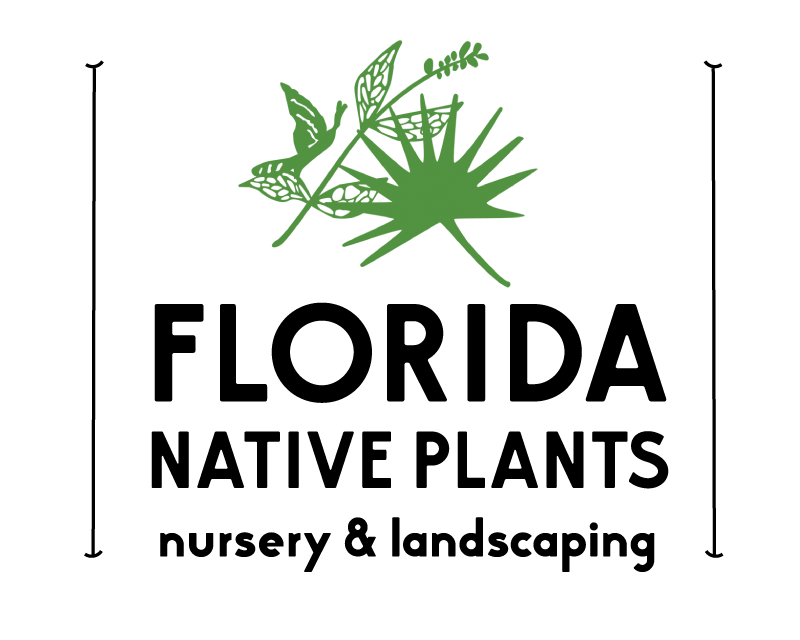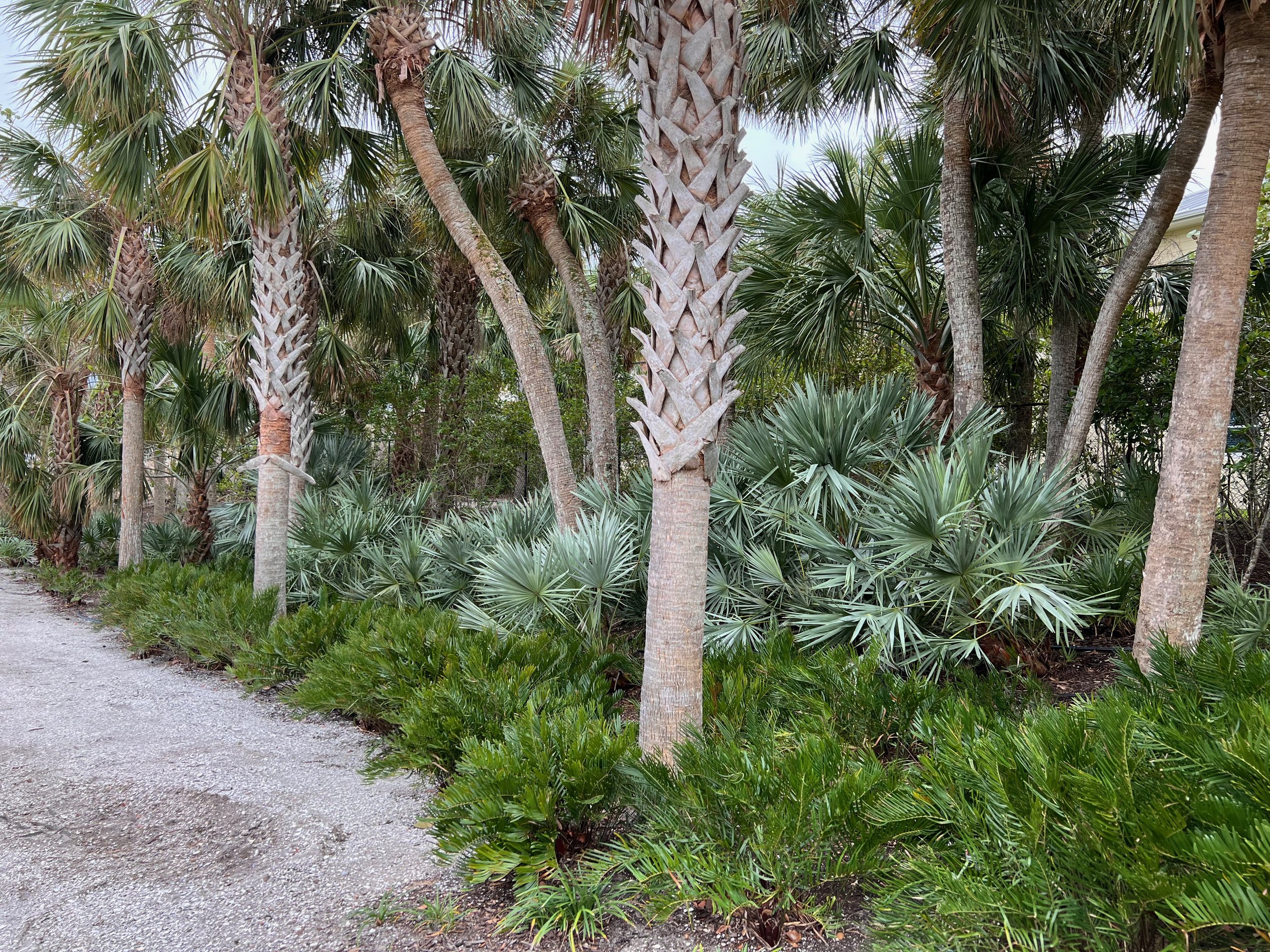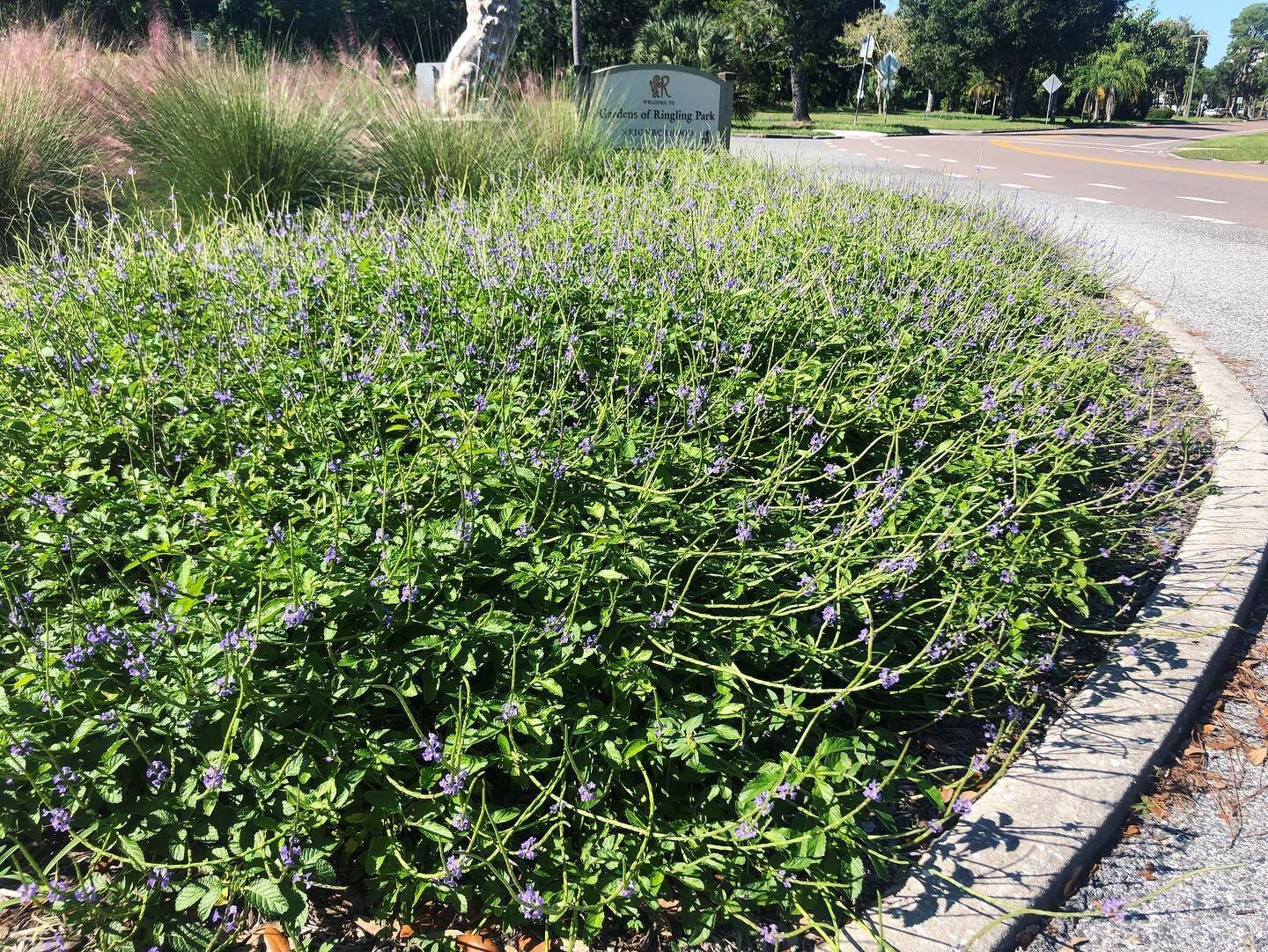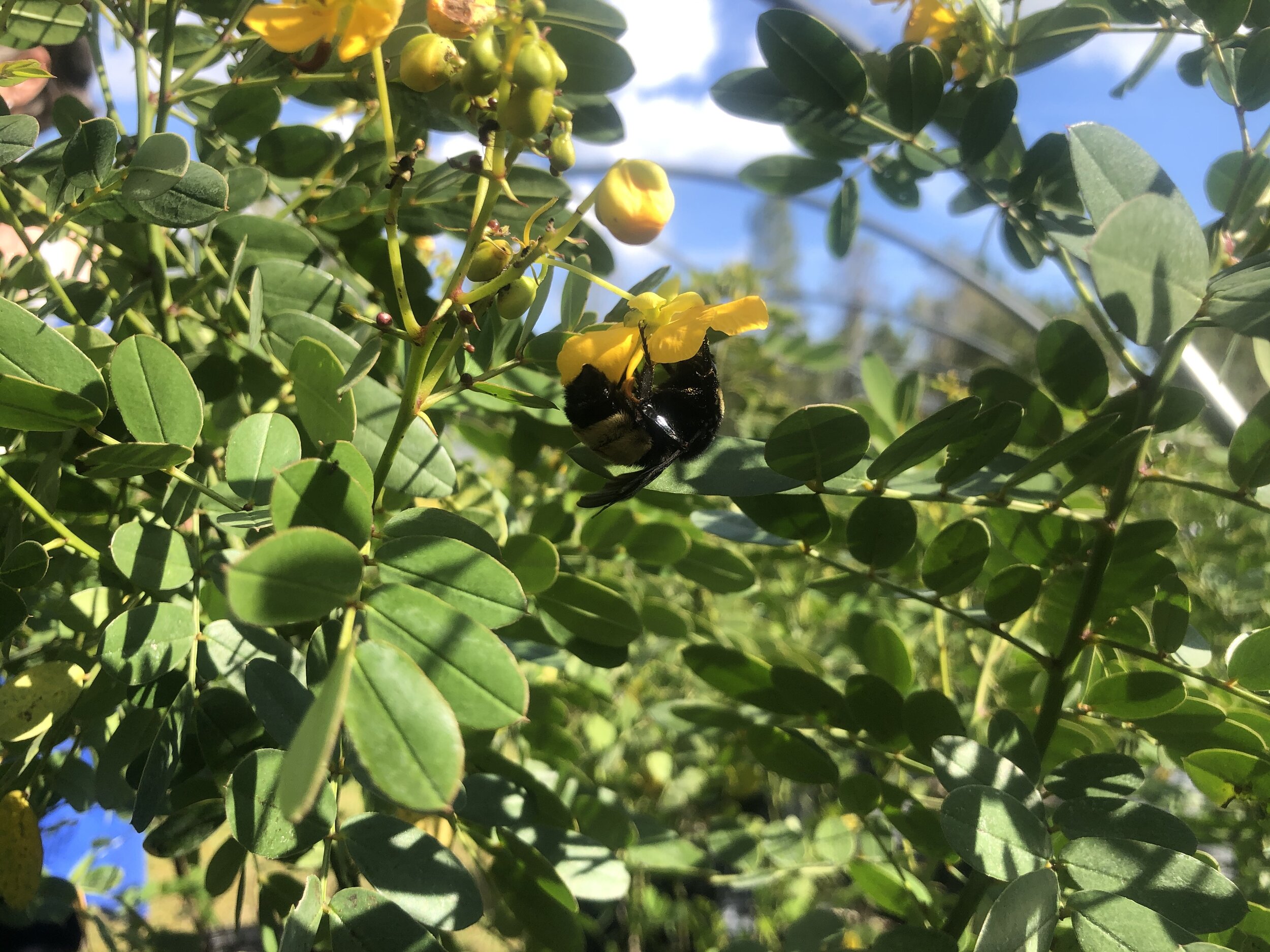Ten Principles for Sustainable Native Landscaping
Written by Laurel Schiller for Florida Native Plants Nursery
Edited by Kristin Hoffschmidt Photos and Design by Annie Schiller
The University of Florida IFAS Extension promotes nine principles for Florida-friendly landscaping. In this article, the Florida Native Plants Nursery uses that framework to present our version of best practices for sustainable landscaping with native plants.
Native plants have evolved over millions of years to adapt to the Florida climate and to be part of an intricate, diverse local food web. Introduced species have not been part of this evolution and many do not provide critical ecological benefits. Instead of planting an Asian, African, or South American landscape in our beautiful state, you can create a healthy, sustainable Florida landscape with native plants by following these ten principles:
Right Plant, Right Place
Water Efficiently
Fertilize Appropriately
Mulch Appropriately
Sustain Wildlife
Manage Yard Pests Responsibly
Recycle Yard “Waste”
Reduce Stormwater Runoff
Protect the Waterfront
Reduce Use of Gas-powered Equipment
Let’s start with some definitions from an article about invasive species terminology:
Native: A species that occurs naturally in a specified geographic area
Introduced: A species brought intentionally or unintentionally to a new geographic area by humans
Invasive: A species that (a) is nonnative to a specified geographic area, (b) was introduced by humans (intentionally or unintentionally), and (c) does or can cause environmental or economic harm or harm to humans. Here’s our “take” on the University of Florida’s nine Florida-Friendly Landscaping principles, which emphasize sustainable landscaping choices for Florida.
Principle #1: Right Plant, Right Place
Florida native plants, once established in the right place, do not require supplemental irrigation, fertilizer, or pesticides. The “right place” is one that has conditions suited to the plant. Native plants have adapted to our varied climate that is cool and dry in winter; hot and dry in spring; and hot and humid in summer. They thrive in nutrient-poor sandy soils that are either excessively drained or waterlogged after heavy rains. Coastal native plants can tolerate salt-laden winds and soils. Native trees have evolved to withstand tropical storm-force winds, and some can even endure hurricane-force winds.
In contrast, non-native plants introduced from elsewhere in the world, including many considered to be Florida-friendly, require irrigation, fertilizer, pesticides, and ongoing maintenance to remain healthy over time. Periodically, Florida-friendly plants become “too friendly” and are removed from approved lists because they become invasive.
A residential road front entrance on Manasota Key that features thriving native plants like coontie, sabal palm and blue saw palmetto.
Principle #2: Water Efficiently
Florida native plants in the right place do not require supplemental irrigation, and reducing turf grass and planting natives conserves our dwindling water resources. Water is a non-renewable resource, and our aquifers are being drained and threatened by saltwater intrusion. Florida is now the third most populous state in the nation and our population is expected to more than double by 2070. It has been estimated that half of the water used in Florida homes goes to landscaping. Extreme weather, including drought, is more intense due to climate change. To have sustainable landscapes now and in the future, Florida’s landscaping must change to use less water.
Native landscape plants can be watered by hand with a hose for the establishment period. A temporary, above ground irrigation system on timers can be installed if time or travel is a factor. Once the right native plants are established in the right places, should not need supplemental irrigation unless there are extreme conditions.
A front yard in Brandon, Florida that has no lawn and instead, utilizes hardy native clump grasses, low shrubs, small trees and groundcovers along with 250 sand and crushed shell on pathways and against the house foundation.
Principle #3: Fertilize Appropriately
Florida native plants in the right places do not require inorganic fertilizers. They’ve been growing unassisted for thousands of years. Leave natural leaf litter beneath native plants, which will decompose over time and release readily available nutrients. Planting natives that do not need fertilizer helps to protect Florida’s water resources from nitrogen and phosphorus contamination, a leading contributor to large, long-lasting harmful algal blooms such as red tide. The physical and economic health of our state depends on limiting the use of nitrogen and phosphorus now and in the future.
Did you know that Sarasota County prohibits the use of fertilizer containing nitrogen or phosphorus from June 1 to September 30? For the rest of the year, any fertilizer used must be at least 50% slow-release nitrogen. Also, Sarasota County soils are naturally rich in phosphorus, so supplements are not necessary.
Native prostrate porterweed and muhly grass planted in full sun and harsh conditions in a roadside circular median in a residential area of Sarasota, Florida. These plants attract and feed numerous pollinators (are host plants as well) and require no fertilizers or irrigation once established.
Principle #4: Mulch Appropriately
Three to six inches of mulch will cool the surface layers of the soil, hold in moisture, suppress weed growth, and slowly add nutrients to garden soils as it breaks down. Use the sources of mulch that are already there: allow dead leaves to accumulate, rake leaves from other areas to landscaping beds, spread wood chips from tree pruning, and compost yard trimmings. Using pine needles or lightly mulching allows wildflowers to reseed. Reduce the need for mulch by installing groundcovers and spreading plants – a green tapestry is much more attractive than an empty, hot, brown expanse. If supplemental mulch is needed while new plants getting established, use sustainably produced commercial mulches such as melaleuca instead of endangered cypress.
Example of a front yard in Sarasota, Florida with no lawn that utilizes pine straw mulch in the garden beds (existing pine trees on the property) and melaleuca mulch in the pathways. Eventually the plants will fill in and mulching will happen naturally from the plants leaf litter, but for the first few years, regular weeding and mulching helps with native plant establishment.
Principle #5: Sustain Wildlife
As a state, Florida has high levels of biodiversity, but also is ranked as one of the highest for risk of species extinction. Massive habitat loss due to rapid development and monocultures of lawn and landscaping with the same non-native, exotic plants have significantly reduced biodiversity in our state. Since 1970, there are an estimated 3 billion fewer birds in North America, and the loss of insect life is described as an “apocalypse” because in addition to plants, insects are the foundation of life on Earth.
Native plants sustain life in your landscape by providing natural food, shelter, and nesting sites for birds, butterflies, bees, and other wildlife. You can imitate nature in your home landscape by creating a biodiverse habitat. Include native trees, shrubs, vines, grasses, wildflowers and groundcovers growing at different levels. Plant a variety of species that flower, fruit, and seed in different seasons to ensure a continuous food source. Leave snags and create brush piles with dead wood. Minimize pruning and other disturbances in areas reserved for wildlife. A water feature will attract many different kinds of wildlife and provide added habitat. For more information, see websites such as Homegrown National Park.
A native bee collecting on a flower from a native yellow necklacepod.
Principle #6: Manage Yard Pests Responsibly
There’s no need to use pesticides in native plant landscapes. Pesticides are frequently used in homes and communities without knowledge about the harm that they cause to children, pets, and the environment. There are alternatives to pesticides for effective management of insects, rodents, and weeds without exposing your family and neighbors to harmful toxic chemicals. (For more information see beyondpesticides.org) . Pesticides kill all insects, including bees and other pollinators, and contribute to the current extinction crisis.
To manage pest insects responsibly, plant a diverse community of native plants to attract and provide habitat for beneficial insects and other wildlife that will feed on unwanted pest species. Keep your foundations dry and inhospitable by removing all plant material within six feet of foundation walls. Sweep away leaf litter from foundation walls and do not irrigate under eaves. Remove vegetation growing or leaning on walls, do not plant close to buildings, and remove tree branches scraping walls and roof areas. These practices will eliminate habitat for pest insects and minimize algae and mold growth on walls. Use rat traps instead of rat poison, which is leading cause of mortality for raptors such as owls, eagles, and hawks, and lethal to pets.
Adding a sign to your yard can help inform those maintaining your property not to spray pesticides, herbicides or fungicides near or in your garden.
Example of 250 sand pathways around the house and appropriate spacing away from the house for native plants in a tight space in urban Sarasota, Florida.
Principle #7: Recycle Yard “Waste”
As noted in Principle #4 (Mulch Appropriately), many plant materials considered to be “waste” can be used as mulch, such as dead leaves. However, the use of clippings from turf grass and non-native plants that are routinely fertilized and treated with toxic chemicals is not recommended. Mulching or creating a compost system for untreated yard “waste” recycles organic materials instead of adding to landfill volume and the amount of methane generated by decaying organic material in the landfill. Natural compost, from native and edible plants that have not been artificially fertilized, is full of microbes and humus providing an environment for the microbial activity needed to cycle or decay natural materials into nutrients. Compost also balances acidity and holds moisture and air in the soil. Mix compost with surrounding soil when planting to help new plants adapt more quickly and with less additional water (Source: Sustainable Gardening for Florida by Ginny Stibolt). Dead wood, such as trunks and branches, creates valuable food and habitat for a variety of organisms.
Principle #8: Reduce Stormwater Runoff
Stormwater that is not naturally filtered but instead is channeled directly into streams, rivers, and ultimately the ocean is a major contributor to water pollution. Simple steps to reduce stormwater runoff can clean and filter the water, replenish the aquifer, add biodiversity, and reduce flooding and the need for supplemental irrigation.
Direct roof runoff away from building foundations and driveways and towards plant beds or into rain barrels. Install native plants along property lines to absorb moisture flowing toward storm drains, and in low areas, add native wetland plants that are adapted to periods of wet and dry conditions. Consider creating a bioswale (a shallow channel with gently sloping sides and native plants) to slow the flow of stormwater and allow it to soak into the ground. Use permeable materials for driveways and walkways instead of concrete.
Native plants help absorb rain and storm water run off (also nutrients and pollution) before they leave your property and ultimately flow into the the Gulf of Mexico.
Principle #9: Protect the Waterfront
If you live near a water body, its water quality depends on a substantial buffer of native trees, shrubs, grasses and groundcovers between the shoreline and your landscape. This vegetative buffer prevents erosion and cleans, filters, and absorbs stormwater runoff before it flows into waterways. It also provides wildlife habitat and corridors that allow wildlife to search for new territories, food, and mates. Water body banks should be gradual and not steep, and rocks or cement walls actually increase erosion and ecological problems. Wetland plants in shallow areas clean the water and prevent algae blooms. Under the Sarasota County ordinances, fertilizer applications must be a minimum of 10 feet away from any water body. See the Healthy Ponds Collaborative for more information.
Example of a native plant buffer of layered shrubs and trees between two properties in Sarasota, Florida.
Principle #10: Reduce the Use of Gas-powered Equipment
Equipment used in traditional landscaping practices is intensely fossil-fuel dependent, and lawn machines are estimated to produce 4 percent of CO2 emissions nationwide. Electric power is better, but mostly depends on burning coal. Lawn and landscape equipment is expensive and creates many health hazards, including excessive noise and air pollution through emissions and dust. Much of the equipment used is not even necessary: excessive pruning and cutting actually makes plants weaker and more susceptible to disease and reduces cover so they need more water. Part of the right plant, right place principle (#1) is to select plants that are an appropriate size and will not require constant trimming.
These principles won’t help unless they are put into action, and the final part is you – using native plants and sustainable landscaping principles in your yard; advocating for these principles with your HOA, condo association, or landlord; sharing this information with friends and neighbors; and advocating with local, regional, and state governments for a more sustainable future.












